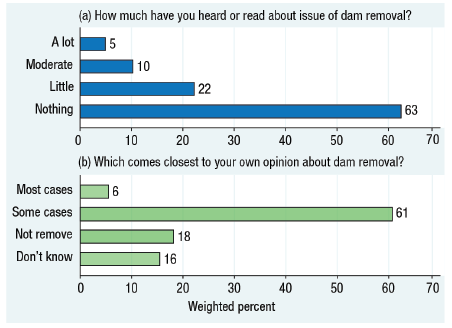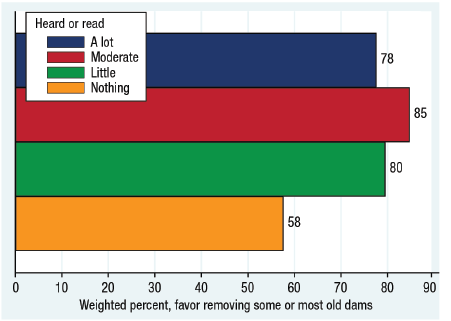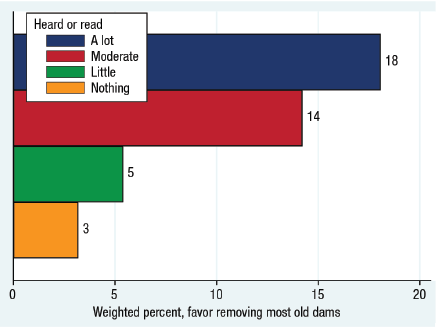Key Findings
On March 13, 1996, the failure of the Meadow Pond Dam in Alton, NH unleashed 92 million gallons of water downstream, causing one death, two injuries, more than $5 million in damage to homes, damage to about a quarter mile of road, and power outages.1 More recent dam failures across the country, such as in Oroville, CA and Midland, MI, highlight the continuing challenges dam owners face in maintaining aging dams and upgrading them to meet current safety requirements. New building in floodplains and more intense rainfall in coming decades will likely make today’s safety challenges more acute. New England, with over 14,000 dams,2 has a dense cluster of older ones and, for many, failure would likely cause loss of life and significant economic damage.3
As a result, dam owners across New England are engaged in contentious policy discussions about what to do with dams that are aging, require costly upgrades, and no longer provide their intended benefits. In many cases the long-term environmental and safety benefits of removing these dams outweigh the short-term costs of removal.4 For example, Exeter, NH decided to remove its historic downtown Great Dam in 2016 in order to restore the Exeter River.5 In other cases, owners of specific dams may decide to repair and maintain a dam for other benefits, such as recreational opportunities, drinking water supply, and community identity. For example, in 2019 voters in Newmarket, NH decided to repair and keep the Macallen Dam on the Lamprey River.6
Publicly owned dams are the most obvious challenge, but the public also has significant influence over the roughly 75 percent of dams in the state that are privately owned. Private as well as municipal dams are eligible to use public funds, such as loans from the state-legislated Dam Maintenance Revolving Loan Fund, for maintenance, repair, improvement, and removal, and grants from the Aquatic Resources Mitigation Fund for preservation, restoration, and enhancement of wetlands and streams. Publicly funded state dam inspectors regulate the repair, reconstruction, maintenance, and operation of dams. And decisions about dams affect the state’s stewardship of natural resources, including water, fish, and wildlife, held in trust for public benefit.
Surveys of Public Opinion
An earlier series of statewide surveys in 2018 provided the first representative data at the state level about how New Hampshire residents weigh different tradeoffs regarding dam removal7 and how demographic factors influence their preferences.8 Faced with tradeoff questions about whether to remove dams or keep them to preserve New Hampshire’s industrial history, recreational opportunities, or waterfront property values, a majority of respondents favored dam removal. Only when the tradeoff involved dams that supply electricity did a majority prefer keeping them instead. In general, younger adults, women, and Democrats more often preferred dam removal.
To effectively steward New Hampshire’s financial, human, and natural resources, it is important to know more about residents’ preferences for keeping or removing dams in general. It is also important to know how salient this issue is for New Hampshire residents and how well informed they feel they are. While to some, dams may seem ubiquitous in New England, do most New Hampshire residents feel they hear and read much about dams? And does what they hear or read make any difference in their preference for keeping or removing dams? To investigate these questions, the October 2018 Granite State Poll9 asked 607 New Hampshire residents the following questions:
There are thousands of dams in rivers all around New Hampshire. Many of these dams no longer serve their intended purpose. For environmental or safety reasons, some people think these dams should be removed. Other people prefer to leave the dams in place. Have you heard or read about the issue of dam removal?
- I have heard or read a lot about dam removal.
- I have heard or read a moderate amount about dam removal.
- I have heard or read a little about dam removal.
- No, I have not heard or read about dam removal.
With regard to keeping or removing dams in New Hampshire, which of the following comes closest to your own opinion?
- I think dams should be removed in most cases.
- Removal may be a good idea in some cases.
- I do not think any dams should be removed.
About the Authors

Simone Chapman is a master of science student in the Natural Resources and the Environment program and a graduate research assistant with a joint appointment in the Environmental Policy, Planning, and Sustainability Lab and the New England Sustainability Consortium Research Program at the University of New Hampshire.

Catherine M. Ashcraft is an assistant professor of natural resources and the environment and a Carsey School of Public Policy faculty fellow at the University of New Hampshire.

Lawrence C. Hamilton is professor of sociology and a senior fellow at the Carsey School of Public Policy at the University of New Hampshire.

Kevin Gardner is executive vice president for research and innovation at the University of Louisville.
Figure 1 charts the responses. An overwhelming majority (85 percent) of respondents said they have heard or read little (22 percent) or nothing (63 percent) about dam removal. Even so, 67 percent considered that old dams should be removed in some or most cases. Only 18 percent opposed any dam removal and 16 percent said they didn’t know. For the majority who have not heard or read about dam removal, our first question’s introductory statement may have provided the most direct information on this issue.
Effects of Knowledge
How does knowledge about dam removal affect people’s opinions? Figures 2 and 3 put the knowledge and opinion questions together. In Figure 2 we see that large majorities (78 to 85 percent) of those who say they have heard a lot, a moderate amount, or a little about this issue favor removing dams in at least some cases. The largest group of respondents, however, is those who say they have heard or read nothing about this issue (see Figure 1). Figure 2 shows that the no-knowledge group is least likely (58 percent) to support dam removal.
Figure 3 focuses on the strongest opinion, that old dams should be removed in most instances. Here the information gradient is steep, ranging from 18 percent support for removing most old dams among those best informed on this topic, to just 3 percent among the least. Taken together, Figures 2 and 3 suggest that a better-informed general public would be more supportive of dam removal for environmental or safety reasons.
Figure 1: Responses to questions about (a) dam-removal information and (b) dam-removal opinions.

Source: NH Granite State Poll, October 2018 (n = 607).
Figure 2: Share of respondents favoring removing some or most old dams, by how much they have heard or read on this issue

Note: The effect of knowledge on opinions is statistically significant (p < 0.001).10
Source: NH Granite State Poll, October 2018 (n = 607).
Figure 3: Share of respondents favoring removing most old dams, by how much they have heard or read on this issue

Note: The effect of knowledge on opinions is statistically significant (p < 0.001).11
Source: NH Granite State Poll, October 2018 (n = 607).
Policy Implications for New Hampshire
Given the significance of dam decisions for state resources, public safety, community identity, and ecosystems, there is a need for information about public preferences to guide stewardship decisions. Our survey results indicate a majority of New Hampshire residents favor removing at least some dams, and support for dam removal rises with level of knowledge: people with at least some knowledge of this topic are more likely to favor removal of some or most dams. Yet a high fraction of New Hampshire residents say they have heard nothing about dam removal issues, and the greatest opposition to dam removal comes from this no-information group.
There is a clear need for enhanced public information about different dam management options—doing nothing, repairing and maintaining them, or removing them—and the associated short-term and long-term costs and benefits. Our findings highlight the importance of communication efforts and the need to better inform New Hampshire residents about dam issues, for example through news stories.
Endnotes
1. “Dam Break in New Hampshire Damages Homes, Washes Out Highway,” U.S. Water News Online, April 1996, web.archive.org/web/20071119115827/www.uswaternews.com/archives/arcsupply/6newhamp.html; “Memories Still Fresh of Alton Disaster 20 Years Ago,” WMUR, March 10, 2016, https://www.wmur.com/article/memories-still-fresh-of-alton-dam-disaster-20-years-ago-1/5209313.
2. F.J. Magilligan, B.E. Graber, K.H. Nislow, J.W. Chipman, C.S. Sneddon, and C.A. Fox, “River Restoration by Dam Removal: Enhancing Connectivity at Watershed Scales,” Elementa: Science of the Anthropocene 4 (2016): 000108.
3. Maya Wei-Haas, “The Problem America Has Neglected for Too Long: Deteriorating Dams,” National Geographic, May 27, 2020, https://www.nationalgeographic.com/science/2020/05/problem-america-neglected-too-long-deteriorating-dams/.
4. F.J. Magilligan, C.S. Sneddon, and C.A. Fox, “The Social, Historical, and Institutional Contingencies of Dam Removal,” Environmental Management 59, no. 6 (2017): 982–94, http://dx.doi.org/10.1007/s00267-017-0835-2.
5. Exeter Historical Society, “Exeter Dam,” www.exeterhistory.org/exeter-dam.
6. Alexander LaCasse, “The Case for Approving $2M Macallen Dam Bond,” Fosters.com, March 2, 2019, www.fosters.com/news/20190302/case-for-approving-2m-macallen-dam-bond.
7. Natallia Leuchanka Diessner, Catherine M. Ashcraft, Kevin H. Gardner, and Lawrence C. Hamilton, “What to Do With Dams: An Assessment of Public Opinion to Inform the Debate in New Hampshire” (Durham, NH: Carsey School of Public Policy, University of New Hampshire, 2019), https://scholars.unh.edu/carsey/374.
8. N.L. Diessner, C.M. Ashcraft, K.H. Gardner, and L.C. Hamilton, “I’ll Be Dammed! Public Preferences Regarding Dam Removal in New Hampshire,” UNH Scholars Repository (2020), https://dx.doi.org/10.34051/p/2020.395.
9. This Granite State Poll survey involved cell and landline telephone interviews of randomly selected adults, carried out by the Survey Center at the University of New Hampshire. In addition to these dam surveys, the Granite State Poll has been widely used both for political polling and scientific research. On environment- and science-related questions, its results often closely resemble those of nationwide surveys. See, for example, L.C. Hamilton, E. Bell, J. Hartter, and J.D. Salerno, “A Change in the Wind? U.S. Public Views on Renewable Energy and Climate Compared,” Energy, Sustainability and Society 8 (2018), https://doi.org/10.1186/s13705-018-0152-5. Sampling weights, which mathematically adjust survey results to represent the state’s population, are used in Figure 1 and other analyses in this brief.
10. Statistical significance results shown in Figures 2 and 3 (p < 0.001 in both cases) reflect t tests from probability-weighted logit regressions of dam opinions on self-assessed knowledge.
11. Ibid.
Acknowledgments
Support for this project is provided by the National Science Foundation’s Research Infrastructure Improvement Program NSF #IIA-1539071. Any opinions, findings, and conclusions or recommendations expressed in this material are those of the authors and do not necessarily reflect the views of the National Science Foundation.
